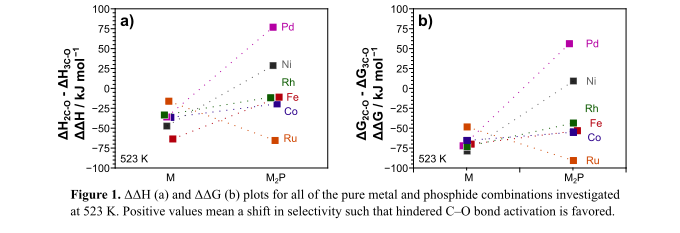For biomass-derived molecules, 2-methyltetrahydrofuran (MTHF) is a model compound that can be used to contrast hindered and unhindered CâO bond activation. MTHF contains a furan ring whose O atom has neighboring secondary (
2CâO) and tertiary (
3CâO) carbons. Supported Ni catalysts activate the unhindered
2CâO bond at a rate 10Ã that for hindered
3CâO bonds in MTHF, as supported by DFT-derived ÎH
act values on Ni(111) surfaces that are 47 kJ mol
â1 lower for
2CâO bond activation. This selectivity shifts toward
3CâO activation as phosphorous is incorporated, with ÎH
act for
3CâO bond activations that are 11 kJ mol
â1 and 29 kJ mol
â1 lower on Ni
12P
5 and Ni
2P, respectively [1]. It remains unclear how P causes these shifts in selectivity, which could occur because of geometric (separation of Ni centers) or electronic effects (withdraw of e
â from Ni). Here, we use DFT calculations to study the effect of P incorporation into other transition metals using surfaces isostructural to Ni(111) and Ni
2P(001) to decouple electronic from geometric effects. Our results show that incorporating P on a series of transition metals consistently shifts selectivities toward
3CâO activation, reflected by the difference in the
2CâO and
3CâO bond activation enthalpies (ÎÎH) and free energies (ÎÎG): Ni
2P, Pd
2P, Rh
2P Fe
2P and Co
2P all have more positive values of ÎÎH and ÎÎG than their pure metal counterparts (Fig. 1). The most dramatic effects of P incorporation are observed in Ni
2P and Pd
2P, and only those two surfaces had lower
3CâO activation barriers than those for
2CâO. These data begin to provide insights into the geometric and electronic effects of P incorporation which appear to cooperatively increase the selectivity toward hindered
3CâO bonds.
References
[1] ACS Catal. 2018, 8, 7141â7157.


